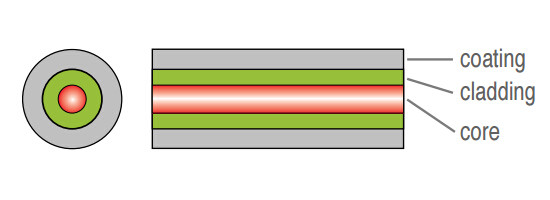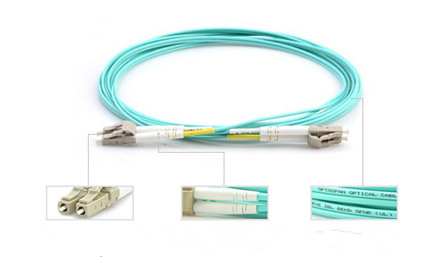Fiber optics, with its high bandwidth capacities and low attenuation characteristics, is considered to be the ideal building equipment in the telecommunication field. Depending on the type of application and the reach to be achieved, various types of optical fiber may be considered and deployed. This article is devoted to provide solutions to the questions about fiber optic cables. After going through the whole passage, you might form a basic understanding of optical cables.
What Is an Optical Fiber?
Core and cladding are the two main elements of an optical fiber. The core as shown in the image below, is the axial part of the optical fiber made of silica glass, which is the light transmission area of the fiber. The cladding is the layer completely surrounding the core. The refractive index of the core is higher than that of the cladding, so that light in the core strikes the interface with the cladding at a bouncing angle, gets trapped in the core by total internal reflection, and keeps traveling in the proper direction down the length of the fiber to its destination.

There is usually another layer, called a coating surrounding the cladding that typically consists of protective polymer layers applied during the fiber drawing process, before the fiber contacts any surface. As we all known, the most typical types of fiber optic cable are MM fiber patch cords and single mode fiber optic cables.
How Do Fiber Optics Work?
Fiber optics use light pulses to transmit signals from one end to another. Light passes through the optical cable, bouncing off the cladding until it reaches the other end of the fiber channel, which is called total internal reflection. The diameter of the core corresponds directly with the angle of reflection.
As this diameter increases, the light requires more reflections and a greater amount of time to travel a given distance. For example, single mode fiber optic cable has a smaller diameter core which makes itself suitable for long distance, higher bandwidth runs. Multimode fiber, however, has a larger diameter core and is more commonly used in shorter cable runs.
What You Need to Know About Optical Fiber?
Attenuation and Wavelength
Light is gradually attenuated when it is propagated along the fiber. The attenuation value is expressed in dB/km. It is a function of the wavelength (λ), meaning that the operating wavelength to transmit a signal in an optical fiber is not any wavelength. It corresponds to a minimum of attenuation.
The typical operating wavelengths that light sources have been developed for are 850 nm and 1300 nm in multimode, and 1310 nm and 1550 nm in single mode. For a 850 nm operating wavelength, there is a 3dB light attenuation after 1 km propagation. 3 dB means that half of the light has been lost.
Bandwidth
Bandwidth is a measure of the data-carrying capacity of an optical fiber. For example, a fiber with a bandwidth of 500 MHz.km (Mega-hertz kilometer) can transmit data at a rate of 500 MHz along one kilometer. Bandwidth in single mode fibers is much higher than in multimode fibers.
How to Link Two Optical Fibers?
Fusion Splice
This operation usually needs a fusion splicer to accomplish the process. In this method, optical technician directly links two fibers together by welding with an electric arc, by aligning best possible both fiber cores. Compared with other method, this linking method is fast and relatively simple to make. And the light loss generated by the welding, due to an imperfect alignment of the cores, remains very weak.
However, just as the coin has two sides, this link method has drawbacks. In spite of a protection of fusion by a heat-shrinkable tube, this type of link is relatively fragile. It is a permanent link. What’s worst, the fusion splicer is usually very expensive.
Use of Connectors
In this case, it is necessary to terminate a connector at each end of the fibers to be connected. The two fibers can then be connected by connecting the two connectors together. The following picture shows a SC fiber patch cord.

Just as the following picture shows, this type of connection is robust. The type of connector can be chosen according to the application field of the system. Unlike fusion splice, this connection is removable. It is possible to connect and disconnect two fibers hundreds to thousands times without damaging the connectors. But the implementation is longer than fusion, and requires an experiment as well as specific tools. Furthermore, the light loss due to connection is higher than in the splicing solution.
Why to Choose Fiber Optics?
The main advantages of fiber optics are the followings:
- Lower loss: Optical fiber has lower attenuation than copper conductors, allowing longer cable runs and fewer repeaters.
- Increased bandwidth: The high signal bandwidth of optical fiber provides a significantly greater information-carrying capacity. Typical bandwidths for multimode fibers are between 200 and 600 MHz.km, and > 10 GHz.km for singlemode fibers. Typical values for electrical conductors are 10 to 25 MHz.km.
- Immunity to interference: Optical fibers are immune to electromagnetic and radio frequency interference and also emit no radiation themselves.
- No detection: Standard fiber optic cables are dielectric, so they cannot be detected by any type of detector.
- Electrical isolation: Fiber optics allows to transmit information between two points at two different electrical potentials, and also next to high voltage equipments.
- Decreased size and weight: Compared to copper conductors of equivalent signal-carrying capacity, fiber optic cables are easier to install, require less duct space, and weight about 10 to 15 times less.
Conclusion
The Internet nowadays is largely based around optical fiber. For those who do not understand fiber optics, they will have confusion and misconceptions when working with fiber optic networks. This article probably will not make you an optical engineer, but it will guide you to touch on a little bit of every topics, from the theoretical to the practical even if you aren’t designing optical networks. FS.COM offers s variety of fiber optic cables with the highest quality and low price. If you are interested, you can contact us.

Thanks for sharing structured cabling companies in dubai
ReplyDelete